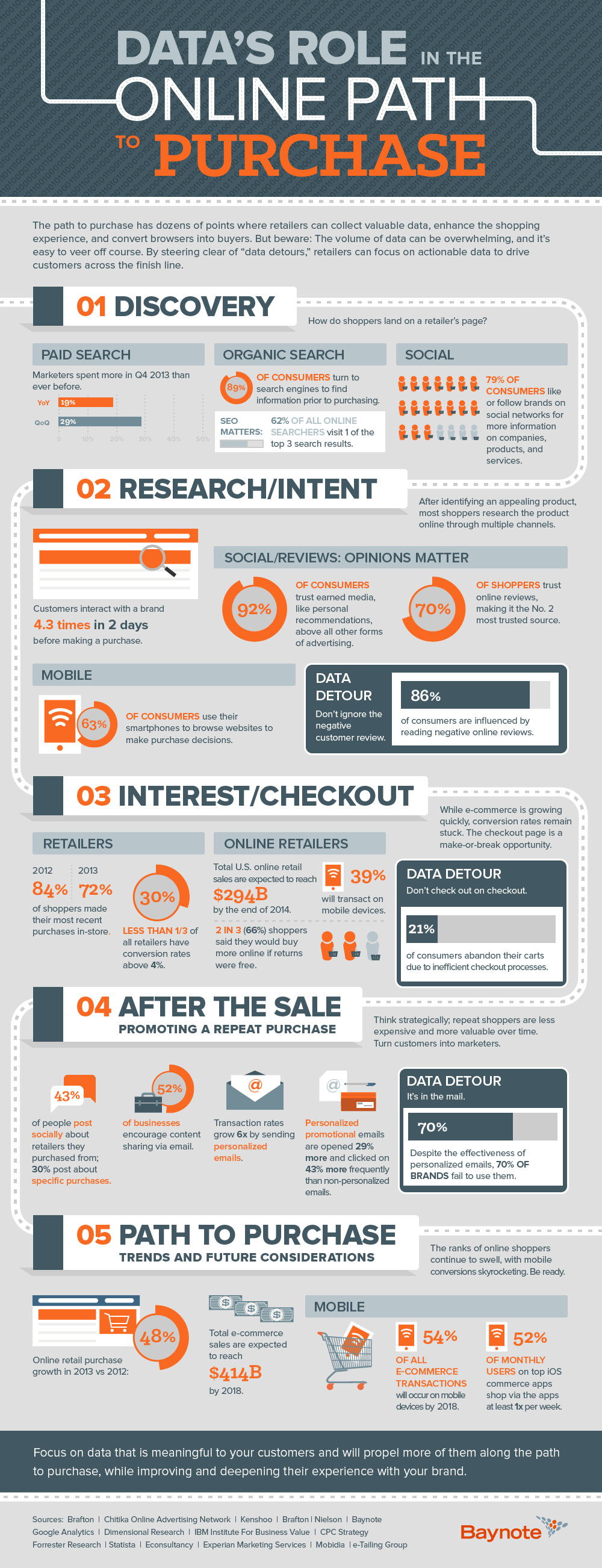 According to a new infographic from Baynote, data plays an important role in the online purchase path (see the infographic at the end of this article), but few companies are effectively navigating through the opportunities and roadblocks that all of the data creates.
According to a new infographic from Baynote, data plays an important role in the online purchase path (see the infographic at the end of this article), but few companies are effectively navigating through the opportunities and roadblocks that all of the data creates.
The infographic breaks the online path to purchase into five distinct steps: discovery, research/intent, interest/checkout, after the sale, and path to purchase future considerations.
Let’s take a look at some of the data to see what’s happening along the path.
The Data
- 89% of consumers use search engines to find information about products before they make a purchase. That’s nine out of 10 shoppers!
- 79% of consumers follow brands on social media to get more information about products, services, and so on.
- 92% of consumers trust earned media (such as personal recommendations) more than any other type of advertising.
- 70% of consumers trust online reviews.
- 86% of consumers are influenced by negative reviews that they read online.
- 21% of consumers abandon their online shopping carts because the checkout process is too inefficient. That’s one in five sales lost!
- 66% of consumers would buy more online if shipping were free.
The data is compelling and points out some fatal flaws that brands are making in their ecommerce strategies. For example, only 30% of brands are sending personalized emails to existing customers to try to increase repeat purchases despite the fact that research shows personalized emails are opened 29% more frequently and clicked on 42% more frequently than non-personalized emails. Furthermore, transaction rates are six times higher for personalized email messages.
Brands are also failing when it comes to mobile. According to the infographic, 54% of ecommerce transactions will happen on mobile devices by 2018, but many brands are still trying to fit their traditional marketing strategies and campaigns into the mobile space. In essence, they’re creating self-inflicted roadblocks that keep them from achieving their growth goals because a growing number of consumers will be frustrated with the brand’s mobile shopping experience.
Key Takeaways
The important thing for brand marketers to understand is that they can take control and remove many of the obstacles that lead to reduced conversions. Listen to the data. Turn roadblocks into checkpoints where you check the data, review the user experience, and make the necessary changes to reduce cart abandonment rates and increase positive reviews and social sharing.
Source: Baynote
Image: Svilen Milev
Susan Gunelius is the author of 10 marketing, social media, branding, copywriting, and technology books, and she is President & CEO of KeySplash Creative, Inc., a marketing communications company. She also owns Women on Business, an award-wining blog for business women. She is a featured columnist for Entrepreneur.com and Forbes.com, and her marketing-related articles have appeared on websites such as MSNBC.com, BusinessWeek.com, TodayShow.com, and more.
She has over 20 years of experience in the marketing field having spent the first decade of her career directing marketing programs for some of the largest companies in the world, including divisions of AT&T and HSBC. Today, her clients include large and small companies around the world and household brands like Citigroup, Cox Communications, Intuit, and more. Susan is frequently interviewed about marketing and branding by television, radio, print, and online media organizations, and she speaks about these topics at events around the world. You can connect with her on Twitter, Facebook, LinkedIn, or Google+.



